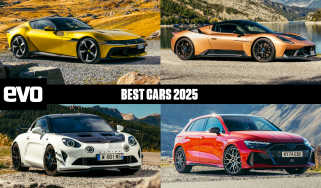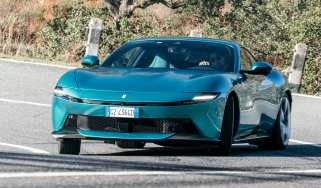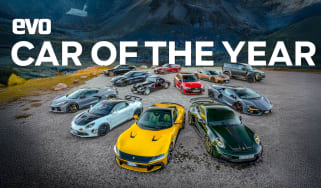Ferrari California: Up Close With The California
Harry Metcalfe visits Maranello to get the lowdown on the new V8 Ferrari
The number one priority for the new California was that it had to be fun to drive. That’s what Ferrari’s technical director Roberto Fedeli explains as he walks me round the car in question. I’m particularly relieved to hear him say this, as when the first press shots of the California arrived at evo a few weeks ago it did look for a moment as if Ferrari might have ‘dropped the ball’ with this car.
Now, seeing it in the metal for the first time, it looks a lot more promising than it did back then. Here it is, with a new 4.3-litre V8 in its nose, a seven-speed dual-clutch transmission, multi-link rear suspension – and that folding metal roof. But what strikes me now, and what I hadn’t appreciated in the original press shots, is that this car is really a new Ferrari V8 coupe that just happens to have a folding roof.
Throughout my day at Maranello, Californias are going in and out of the factory on their routine development drives (Ferrari personnel later admit to me that they’ve built around 50 Californias so far), but all are being driven with the roof up. And seen like that – as a ‘baby’ Ferrari 599 with near-perfect 46/54 weight distribution, 454bhp and a 8000rpm red line – the new model suddenly seems a whole lot more appealing.
I’m keen to find out more about the dual-clutch transmission, Ferrari’s first. Why move away from the ‘F1’ automated manual transmission the company has been so keen on using up until now?
According to Fedeli, it comes back to that ‘fun to drive’ priority. This car needs to be as good in auto mode as in ‘Race’ mode, plus it has to be as maintenance-free as is possible as this car is expected to cover more miles per year than any other Ferrari model – the projected average is over 12,000 miles per year. Ferrari likes to think of the California as an ‘A to B’ car. In other words, one that is capable of both taking luggage and being enjoyable to drive over long distances. (An Enzo or 430 Scuderia is categorised as an ‘A to A’ car – one that you take on a special trip, perhaps to a trackday, before returning home the same day.)
Fedeli admits that in the early stages he and his team looked at using one of the latest torque-converter auto gearboxes, but this idea was soon dismissed as they couldn’t deliver the fun factor being sought for the California. So for the last two years a lot of hard work has been put into making the Dual Clutch Transmission, or DCT, feel as sporting as the current F1 transmission – and Fedeli admits it’s been tricky. The final breakthrough came with a substantial redesign that shortened the pipe between the pump and the oil-immersed clutches, minimising the delay in response to gearchange requests (unlike BMW’s dual-clutch system, Ferrari’s uses oil-immersed clutches, not dry ones, enabling it to handle much higher levels of torque, suggesting that this gearbox may soon appear in its V12 cars).
With seven speeds and no break in torque between gearshifts, acceleration should be fantastic. Helped by a launch control system, this 1700kg car is said to be able to rush from standstill to 60mph in under 4sec – well within the parameters Ferrari had set for the car at the design stage.
The California’s V8 is also the first Ferrari engine to have direct fuel injection, which has the dual benefits of increasing power and reducing emissions, enabling Ferrari to get the power it wanted without increasing the size of the engine.
Efforts have been made to reduce weight wherever possible, but Fedeli admits there are no easy routes to be taken any more as all Ferraris are already built from lightweight materials. One obvious way to make savings is to reduce the size of the car itself, and if you look at the California in profile you’ll notice just how short the overhangs are (80 per cent of the mass is between the axles). Meanwhile, magnesium plays a significant part in some of the supporting structure for the dashboard and centre console, and carbonfibre is used in the seats. There are also lightweight carbon brakes as standard, and Ferrari is looking at producing new forged road wheels that will save another 10-12kg overall.
Also high on Fedeli’s list of priorities was making sure the car sounds good to its occupants, for while Ferraris may make a spectacular noice for those outside them, Fedeli admits that more could be done to enhance the sound for those inside. To this end, the California engine’s induction system has been developed to transmit more of its glorious V8 noise into the cabin. The exhaust, conversely, has been designed so as not to be too intrusive when the roof is down, but one of the disappointments for those with keen eyes will be that those controversial stacked exhausts are in fact dummies – the real exhaust outlets hide inside them and look nothing like as meaty as you’d expect on a car like this.
While Fedeli is going through the final details of the California, Ferrari’s product marketing director, Massimo Fumarola, arrives to talk about the car’s positioning in the market.
‘This sector is booming,’ he insists. ‘Look at how successful the Bentley Continental GT and DB9 have been. Ferrari needed to build this car to plug a gap in our range. It needed to be a car without excesses to succeed. It also needs to deliver value to the customer.’
I ask what the California will cost when it goes on sale later this year, but ‘plus or minus five per cent of the price of an F430 coupe’ is all Massimo will commit to at this stage, although later he changes this to ten per cent either way, while another Ferrari spokesperson pitches in with an expected price of around £5000 more than an F430 coupe, so your guess is as good as ours.
A real surprise comes when Massimo confirms there will be a manual version of the California too. ‘Around 10 per cent of Ferrari customers still demand a manual gearbox in our cars, particularly in the US and the UK,’ he explains. I’m amazed – the California’s interior was specifically designed around the idea of it being fitted solely with a DCT.
The surprises don’t stop there, either. ‘I would like to develop an HGTC package for the car too,’ says Massimo. ‘This really is a drivers’ car. The manual will be available around six months after the initial launch, so just in time for the right-hand-drive launch in the UK. The HGTC pack should be available around then too.’
So this really is a drivers’ car, then. Several Ferrari personnel have already told me how impressed those lucky enough to have driven the California have been. Schumacher has also been closely involved with its development and, in particular, is pleased with the work he’s done on steering feel, braking and body control.
We’ll have to wait until October before we can give you our verdict, but the omens look a whole lot better now we know it’s so much more than just the automatic, convertible Merc SL rival it first appeared to be.
Also in the pipeline at Ferrari...
1 Ferrari certainly isn’t standing still when it comes to reducing emissions from its cars. Technical director Roberto Fedeli confirms the company is looking at ways of including the new KERS (Kinetic Energy Recovery Systems) being developed for its F1 cars into future road cars, but adds, ‘We will never build a hybrid Ferrari.’
2 Turbo technology is being looked at, but this doesn’t mean it will make production. ‘We have to investigate every solution to find the one that suits Ferrari best,’ explains Fedeli. ‘That includes stop-start solutions too.’ When you consider that, at launch, the F430 had a CO2 rating of 450g/km and now, in the California, a similar-sized engine in a heavier car is down to 305g/km, you can see how far Ferrari has come over the last four years.
3 In answer to the question of whether the Ferrari V12 engine can survive the current march towards lower emissions, Fedeli explains it’s not the number of cylinders that leads to high emissions but the size of the engine. ‘So long as the engineers can meet our goals then Ferrari will continue to use V12 engines for its top cars,’ he says. ‘A V10 is not the same.’ Just don’t be surprised if Ferrari’s V12 engines come down in capacity in the future.
4 Does the folding metal hard-top on the California spell the end of the fabric roof at Ferrari? Maybe. An engineer told me not to expect a true Spider derivative of next year’s F430 replacement. Instead a version with an electrically operated targa top could take its place.



